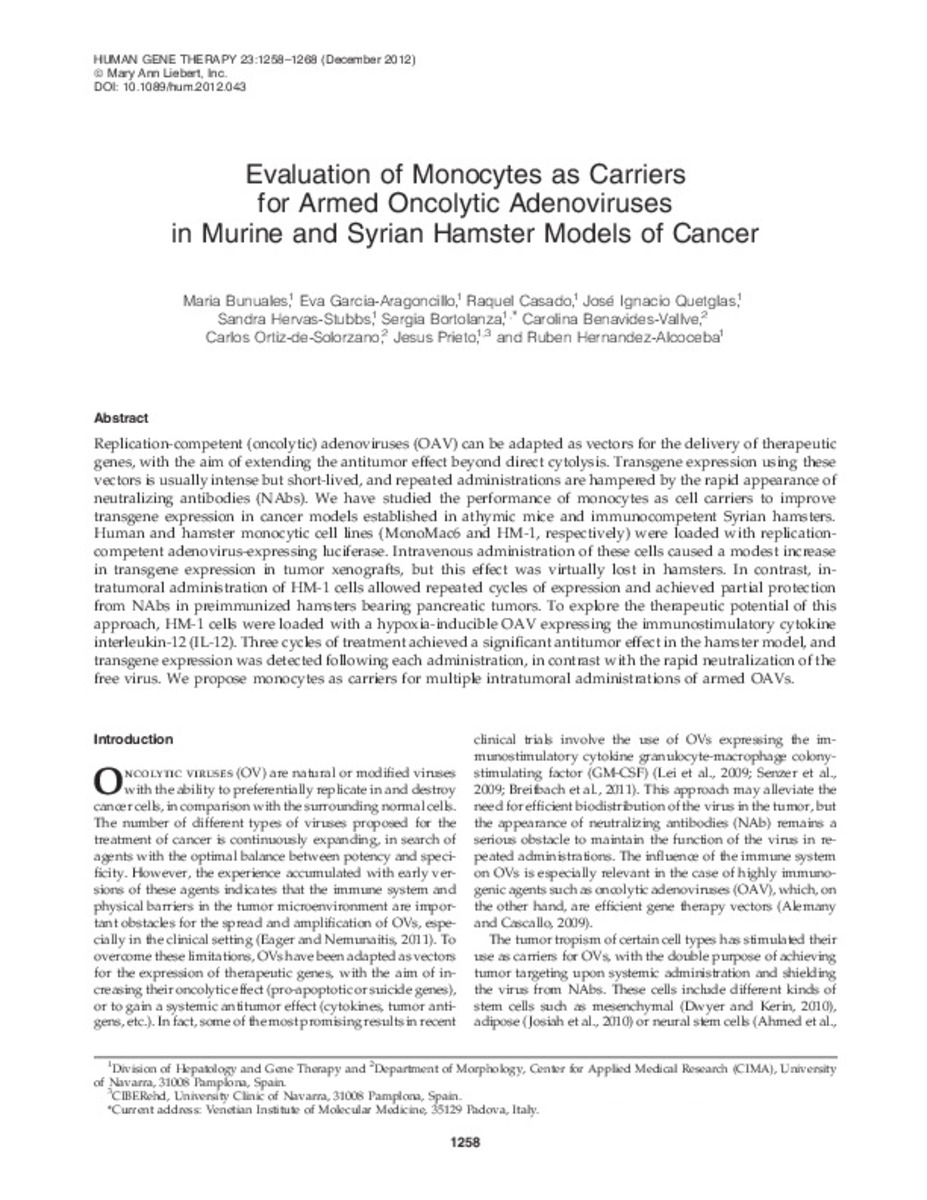Full metadata record
| DC Field | Value | Language |
|---|---|---|
| dc.creator | Buñuales, M. (María) | - |
| dc.creator | Garcia-Aragoncillo, E. (Eva) | - |
| dc.creator | Raquel | - |
| dc.creator | Quetglas, J.I. (José Ignacio) | - |
| dc.creator | Hervas-Stubbs, S. (Sandra) | - |
| dc.creator | Bortolanza, S. (Sergia) | - |
| dc.creator | Benavides, C. (Carolina) | - |
| dc.creator | Ortiz-de-Solorzano, C. (Carlos) | - |
| dc.creator | Prieto, J. (Jesús) | - |
| dc.creator | Hernandez-Alcoceba, R. (Rubén) | - |
| dc.date.accessioned | 2013-02-25T13:31:05Z | - |
| dc.date.available | 2013-02-25T13:31:05Z | - |
| dc.date.issued | 2012 | - |
| dc.identifier.citation | Bunuales M, Garcia-Aragoncillo E, Casado R, Quetglas JI, Hervas-Stubbs S, Bortolanza S, et al. Evaluation of monocytes as carriers for armed oncolytic adenoviruses in murine and Syrian hamster models of cancer. Hum Gene Ther 2012 Dec;23(12):1258-1268. | es_ES |
| dc.identifier.issn | 1557-7422 | - |
| dc.identifier.uri | https://hdl.handle.net/10171/27971 | - |
| dc.description.abstract | Replication-competent (oncolytic) adenoviruses (OAV) can be adapted as vectors for the delivery of therapeutic genes, with the aim of extending the antitumor effect beyond direct cytolysis. Transgene expression using these vectors is usually intense but short-lived, and repeated administrations are hampered by the rapid appearance of neutralizing antibodies (NAbs). We have studied the performance of monocytes as cell carriers to improve transgene expression in cancer models established in athymic mice and immunocompetent Syrian hamsters. Human and hamster monocytic cell lines (MonoMac6 and HM-1, respectively) were loaded with replication-competent adenovirus-expressing luciferase. Intravenous administration of these cells caused a modest increase in transgene expression in tumor xenografts, but this effect was virtually lost in hamsters. In contrast, intratumoral administration of HM-1 cells allowed repeated cycles of expression and achieved partial protection from NAbs in preimmunized hamsters bearing pancreatic tumors. To explore the therapeutic potential of this approach, HM-1 cells were loaded with a hypoxia-inducible OAV expressing the immunostimulatory cytokine interleukin-12 (IL-12). Three cycles of treatment achieved a significant antitumor effect in the hamster model, and transgene expression was detected following each administration, in contrast with the rapid neutralization of the free virus. We propose monocytes as carriers for multiple intratumoral administrations of armed OAVs. | es_ES |
| dc.language.iso | eng | es_ES |
| dc.language.iso | eng | es_ES |
| dc.publisher | Mary Ann Liebert | es_ES |
| dc.rights | info:eu-repo/semantics/openAccess | es_ES |
| dc.subject | Monocytes | es_ES |
| dc.subject | Carriers | es_ES |
| dc.subject | Adenoviruses | es_ES |
| dc.subject | Oncology | es_ES |
| dc.subject | Cancer | es_ES |
| dc.subject | Hamster | es_ES |
| dc.title | Evaluation of monocytes as carriers for armed oncolytic adenoviruses in murine and Syrian hamster models of cancer | es_ES |
| dc.type | info:eu-repo/semantics/article | es_ES |
| dc.relation.publisherversion | http://online.liebertpub.com/doi/abs/10.1089/hum.2012.043 | es_ES |
| dc.type.driver | info:eu-repo/semantics/article | es_ES |
Files in This Item:
Statistics and impact
Items in Dadun are protected by copyright, with all rights reserved, unless otherwise indicated.






